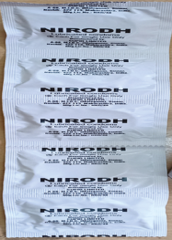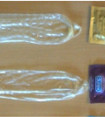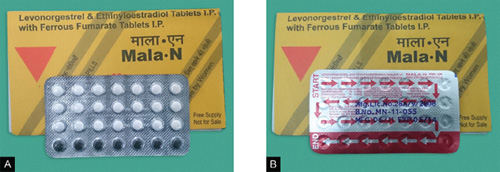
Contraceptives are Broadly Divided into Two Classes
1. Spacing methods
2. Terminal methods
Spacing methods
1. Barrier methods: Physical, Chemical & Combined
2. Intrauterine devices:
– Non – medicated (1st gen.) & Medicated (2nd & 3rd gen)
3. Hormonal methods:
– Oral pills and injectable Depot formulations
4. Post-conceptional methods:
– Menstrual regulation
– Menstrual induction
– Oral abortifacient
– MTP
5. Miscellaneous:
– Abstinence, Coitus interruptus, Safe period (Rhythm) method
6. Natural family planning methods: Not very reliable
– Basal body temperature (BBT) method:
– Cervical mucus method: observing change in the cervical mucus
– Symptothermic method: combination of temperature, safe period & cervical mucus method
• Breastfeeding: Only the initial 6 months or till menstruation begins, whichever is earlier
Terminal methods
1. Male sterilization
2. Female sterilization
BARRIER METHODS
1. Condom 

2. Female condom 
• Polyurethane pouch to be worn by the female before the intercourse
3. Diaphragm 

• Vaginal barrier, Also k/a ‘Dutch cap’
• To be inserted into the vagina and fitted over the cervix using the fingers
• A spermicidal jelly is to be filled into it before insertion.
3. SPERMICIDAL JELLY AND VAGINAL PESSARY 
INTRAUTERINE DEVICES
• IUCDs are of Two Types
1. Non-medicated or inert: first-generation intrauterine devices
2. Medicated or bioactive: second & third generation
• Second-gen. IUDs: release copper (Cu–bearing)
• Third-generation IUDs: release hormones
1. LIPPES LOOP
• Acts by inducing local inflammation in the uterine cavity.
2. COPPER–T & MULTILOAD 

Mechanism of action of Cu-T:
a. Induces mild inflammation in the endometrium.
– lead to incapacitation of the ovum.
– Hence the chances of its fertilization are reduced.
b. Alteration of biochemical composition of cervical mucus
– Inhibits the motility and survival of the sperms.
– sperm incapacitated for fertilization
c. Changes the milieu of the endometrial lining
– Inhospitable for the implantation
3. Hormone Releasing IUD 
Releases progestin Locally
• Thickens cervical mucus
• Thins the lining of the uterus
• May partially suppress ovulation
ORAL CONTRACEPTION
Hormonal
• Combined hormonal contraceptives 

– Contain both an estrogen and a progestin
• Progestin-only contraceptives progesterone 
– Progestin-only pill (POP)
– Emergency contraceptive pill (ECP) containing Levonorgestrel
Non-hormonal
• Centchroman (Ormeloxifene) 
INJECTABLE CONTRACEPTIVES (DMPA) 
Mechanism of Action
• Inhibiting ovulation by suppressing mid cycle peaks of LH and FSH
• Thickening of cervical mucus due to depletion of estrogen
TERMINAL METHODS OF CONTRACEPTION (STERILIZATION)
• Vasectomy 
• Tubal Ligation 
Some Facts regarding terminal methods:
• One of the two surgical procedures may be used for female sterilization.
1. Laparoscopy:
2. Mini laparotomy (minilap):
• Male sterilization: Vasectomy
• Vasectomy (esp. Non-Scalpel vasectomy) is preferable over tubectomy as it is simple, safer, and cheaper than tubectomy
• Tubectomy/Vasectomy candidate may be compensated for a failure of a sterilization surgery
References
• Tiwari, P. (2013). Mastering Practicals in Community Medicine. India: Wolters Kluwer Health.
• Park’s Textbook of Preventive and Social Medicine
